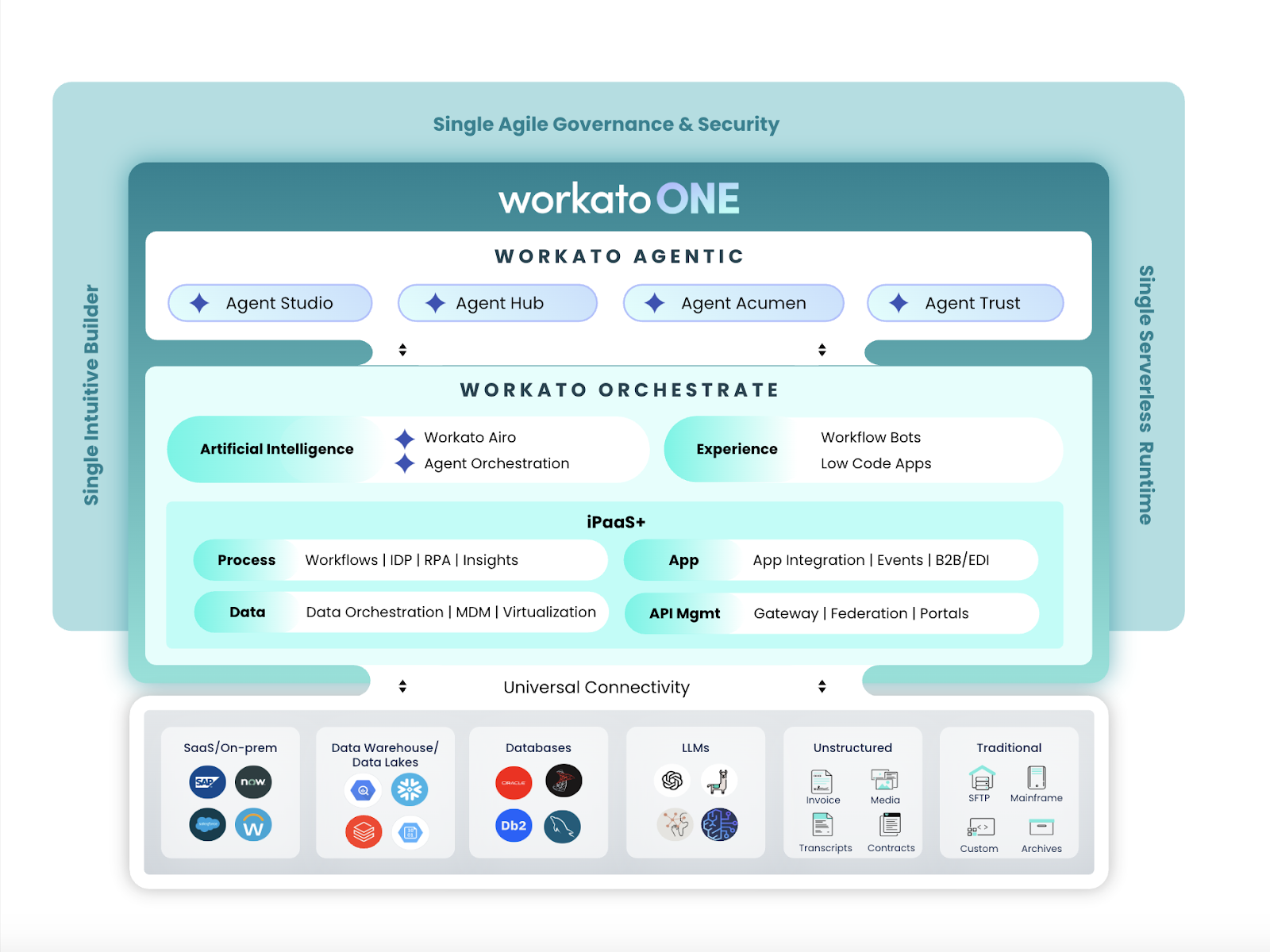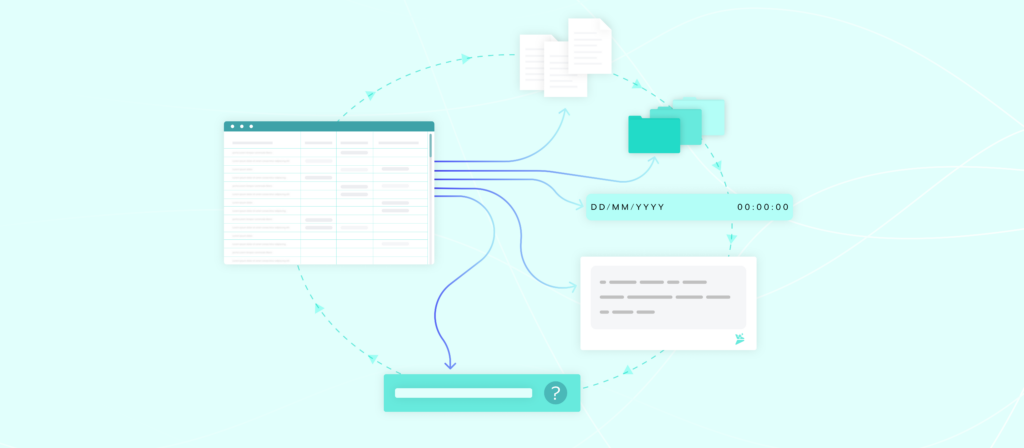Introduction
AI is here to stay. However, many enterprises find that the real challenge isn’t choosing the right model but ensuring that their mission-critical data, systems, and workflows are prepared for sweeping AI adoption. After all, AI doesn’t thrive in restrictive silos or brittle integrations; it requires clean data, seamless automation, and the ability to operate with context. Enter Workato. Not just an integration platform, Workato acts as the operational backbone that transforms your business into an AI-capable enterprise.
AI Without Integration Is Just Hype
AI tools are everywhere, but they face critical limitations:
- The AI revolution is accelerating, with new models and assistants launching almost daily
- While many AI tools deliver impressive results in controlled environments, they struggle with real business challenges
- The fundamental limitation: AI tools only know what’s inside their own system
- Business outcomes that truly matter—improving sales forecasts, resolving customer issues faster, and reducing spend—require data from multiple systems
The integration challenge:
- Many platforms suggest simply “bringing the data in,” but this oversimplifies a complex problem
- Copying information between systems without proper orchestration creates serious risks:
- Lack of context
- Missing security controls
- Inadequate governance
- The real challenge isn’t just access to data, but context, flow, and trust
- Current platforms may move data, but they don’t effectively move decisions
How Workato changes the equation:
- We recognize that modern data isn’t just rows and columns—it’s files, logs, prompts, questions, and user behavior
- Our focus isn’t collecting everything, but activating the right data at the right time across your business stack
- Just as employees need timely, relevant information to perform effectively, so does AI
- Workato delivers orchestration that’s secure, scalable, and context-rich, making AI truly valuable for business
Key Components of AI-Ready Organizations
If you ask most companies if they’re ready for AI, the answer is usually yes. But things get fuzzier if you ask how. In truth, AI readiness isn’t a single checkbox, and it’s more of a reflection of how mature your business operations are beneath the surface. More often than not, it’s about what surrounds your AI, not the AI itself. That’s why we start with operations, not models.
AI readiness begins with a hard look at your core systems. Are your SaaS platforms in order? Are they integrated natively, or through other tools? Are in-flight activities (approvals, customer actions, handoffs) being tracked and contextualized in real time? Is your information being unified, enriched, and governed?
These aren’t IT questions; they’re orchestration questions and are the foundation of AI maturity.

Three Pillars of AI-Orchestration Maturity
Connected Systems
Your apps, teams, and tools need to communicate with each other. If your SaaS stack is fragmented, your data also leads to misinformed AI.
Context in Motion
Orchestration isn’t just about moving data from A to B. It’s about tracking what’s happening right now. Actions. Prompts. Approvals. Threads. Events. AI doesn’t just need data—it needs context, which only comes from live, event-driven orchestration.
Adaptive Infrastructure
You need a platform that lets you work across APIs, apps, files, models, and human workflows—all without creating bottlenecks. That means low-code tools that don’t compromise power, automation that respects governance, and AI that works with the grain of your business, not against it.
Workato unifies systems and operations. With the launch of Workato One, the platform brings APIs, AI agents, automation, human-in-the-loop approvals, governance, and extensibility into a single, composable layer. You’re not duct-taping workflows together—you’re designing the infrastructure AI can thrive on.
Unlike older integration models built around static pipelines, Workato is designed for this new era, where what counts as “data” constantly expands. It’s not just rows and fields anymore. It’s files, logs, messages, triggers, and user behavior. Workato turns all of that into something orchestrated, and that’s what AI needs most.
Why Workato Is The Ideal Partner For The AI Era
Most companies underestimate what’s possible until they see it in action. With Workato, it’s not just that you can integrate systems. You can build automations across tools, teams, and channels in days, and start layering in AI with a single interaction.
The surprise for many? Just how easy it is to go from idea to execution. A workflow that touches five systems, tracks an exception, sends a notification to Teams, and plugs into an AI agent for validation doesn’t take six weeks to build. It takes an afternoon. And suddenly, the “AI initiative” that felt like a moonshot is just another recipe.
That kind of agility comes from Workato’s full functionality suite: APIs, app connectors, event triggers, human approvals, observability, and now AI agents all in one place. People often don’t realize that you can plug a GPT-powered assistant directly into Teams or Slack and start making smarter decisions today.
The aha moments happen when customers move from “point-to-point” thinking to orchestration thinking. It starts simple: “We just want to get orders from Salesforce into NetSuite.” Then it clicks:
“Wait, we can send exceptions to Teams?”
“We can add a button to re-run the job?”
“We can pass the exception to an agent that audits the order and suggests a fix?”
That’s not just AI readiness. That’s operational reinvention—with Workato as the engine behind it.
What AI Readiness Looks Like In Practice
Many companies struggle with implementing AI in their business processes. Here’s a real-world example from our work with companies that illustrates how orchestration becomes the foundation for AI readiness, specifically an order-to-cash flow.
With Workato, that starts with a recipe. Here’s how it works:
- Orders flow automatically into NetSuite from Salesforce
- If something fails, the system identifies specific issues:
- Missing PO numbers
- Pricing mismatches
- Duplicate customers
- Exceptions trigger Teams messages to the right owner with complete order context
- A “Reprocess Order” button enables one-click resolution without console login
A Workato-connected agent is added to the flow. It scans the failed record, runs a lightweight audit based on predefined business rules and GPT logic, and returns a probable reason: “Customer’s account was suspended due to a billing flag.” Humans can act or approve a downstream automation to handle it. No handoffs, no tickets, just orchestration.
What started as a basic integration turns into an intelligent, self-healing process. And none of it required rebuilding systems, hiring AI specialists, or waiting for a quarterly release cycle. That’s what AI readiness looks like: when orchestration is already in place.
Looking Forward to the Scaled AI Era
If there’s one takeaway from this, AI isn’t a magic switch. It doesn’t work in a vacuum and won’t fix foundational gaps in your operations. But with the right orchestration layer, the possibilities expand quickly and meaningfully. That’s where Workato stands apart. It’s not just that it connects systems. It wraps intelligence around your operations. It brings automation, integration, and AI into a single, secure, adaptable layer—accessible to the people closest to the business problem. No massive rebuild. No years-long roadmap. No compromises. With Workato, you can start small, move fast, and scale up confidently. Now’s the time to assess your orchestration readiness. Because AI is coming, and what you’ve built underneath will make all the difference.
Interested to learn more? Sign up for a demo today.
Cory Schwarzschild is CRO – Strategic Partnerships and Alliances at Solomon Consulting
